Sweet shankarpali is an Indian sweet snack that is commonly enjoyed during festivals and special occasions. Shankarpali has a lovely crunch and a slightly sweet taste. It can be stored in an airtight container for up to 2 weeks. Shakkapara is commonly made during festivals like Diwali, Janmashtami, and Holi. Check out more Diwali recipes here. Want to try a unique fusion dessert? Check out this raspberry kalakand.
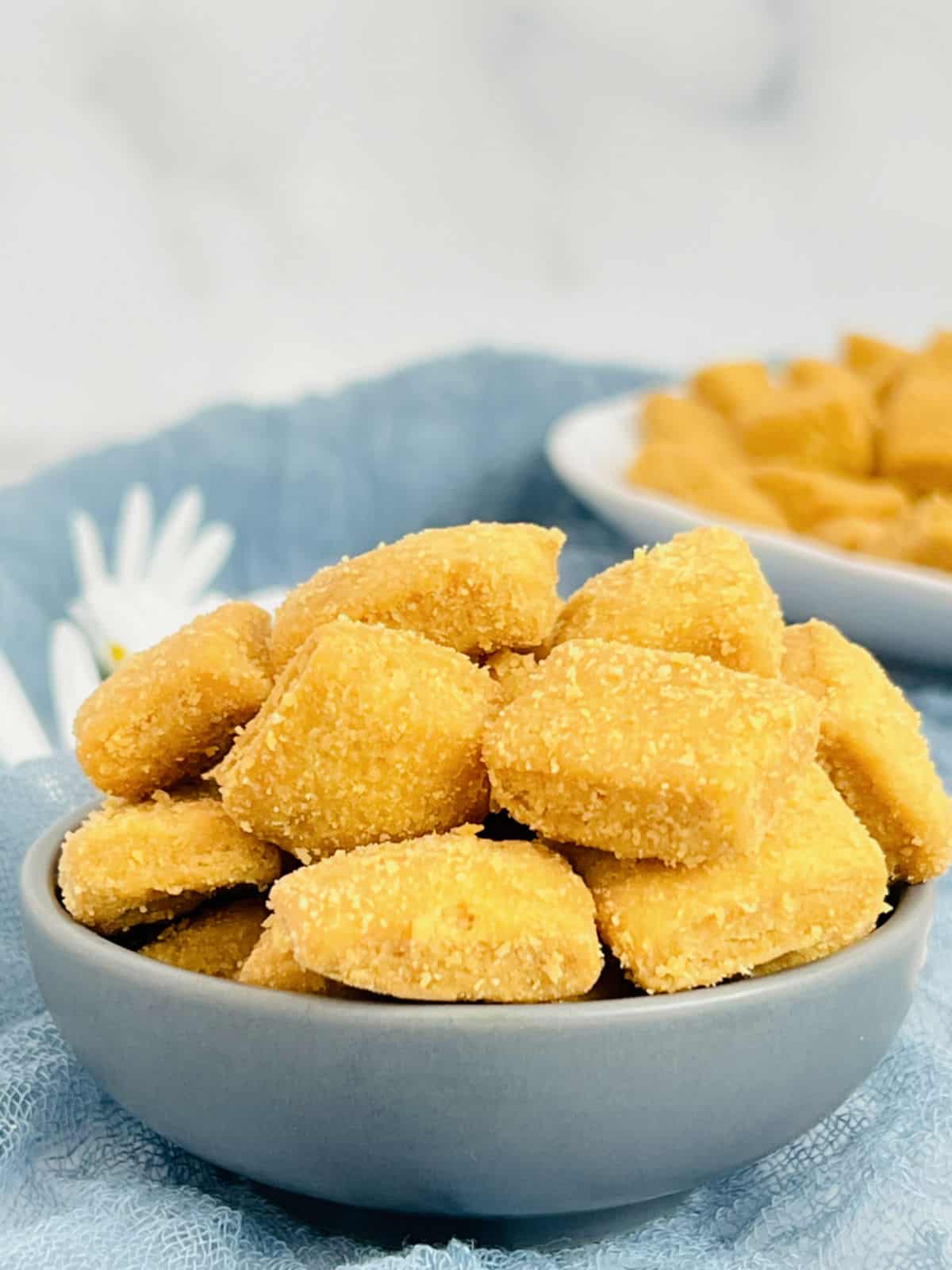
Why you will love this recipe?
- It is a delicious and addictive snack. The combination of the crispy texture and the sweet flavor is simply irresistible.
- It is easy to make. This shankarpali recipe only requires a few simple ingredients and steps.
- Sweet shankarpali is a festive snack.
- Shankarpali has a long shelf life. Once prepared, it can be stored in an airtight container for 2 weeks without compromising its taste and texture.
Two main varieties of shankarpali
There are two main variations of shankarpali - sweet and spicy.
Sweet shankarpali is made with a dough of all-purpose flour, ghee, and sugar. It is then deep-fried until golden brown. Sweet shankarpali is typically shaped into square-shaped pieces and has a crispy and flaky texture. It is often served as a tea-time snack, or as a dessert.
Spicy shankarpali is made with a dough of all-purpose flour, salt, and spices. It is then deep-fried until golden brown. Savory shankarpali is typically shaped into diamond-shaped pieces and has a crispy and savory texture. It is often served as a snack with tea, or as a side dish with meals.
Ingredients
Plain flour: All-purpose flour or maida is the main ingredient.
Ghee: Ghee makes the shankarpali crispy.
Milk: Use whole milk for the best-tasting shankarpali.
Sugar: You can use either plain or raw sugar to make them.
Semolina: Semolina (suji) adds a great texture and crunch.
Step-by-step instructions
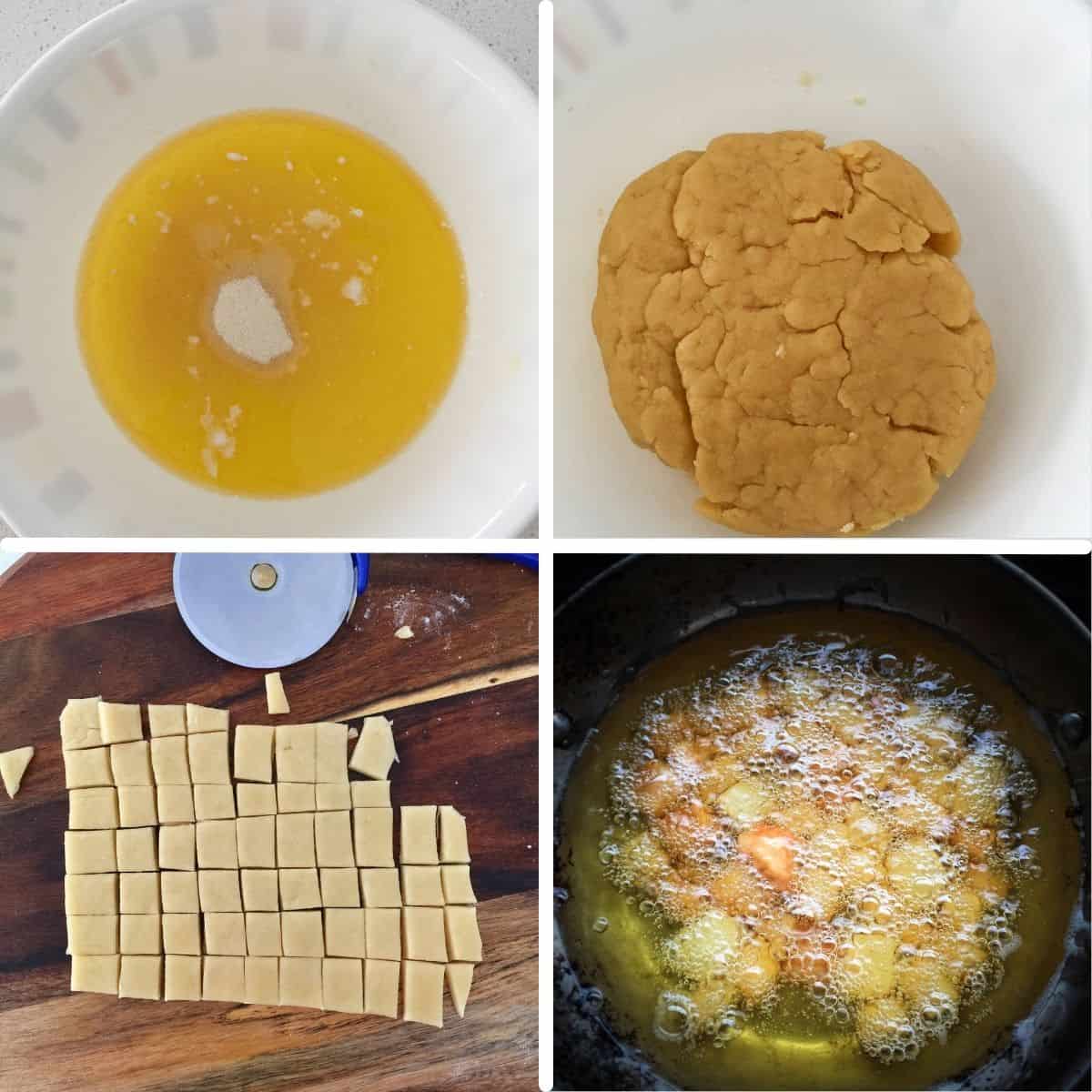
Step 1: In a saucepan, mix milk and ghee. Heat on medium heat until the ghee melts. Remove the milk and melted ghee mixture from the heat and mix the sugar, salt, and semolina into it. Let the sugar dissolve completely.
Step 2: Transfer it to a large mixing bowl. Slowly add the flour to the mixture and knead together into a stiff dough. It is important not to over-knead dough at this stage. Just bring it together and let it rest. Cover with a damp kitchen towel and let the dough rest for 30 minutes.
Step 3: Once the dough has rested, knead it well for a couple of minutes. Divide them roughly into 4 equal parts. Roll out the dough into thick discs. Cut into small squares using a pizza cutter or knife. Rest the cut shapes for 15 minutes.
Step 4: Heat oil in a deep

Step 5: Fry them until they are golden brown and crispy.
Expert Tips
Do not over-knead the dough. This is really important when you are initially mixing the dough. Mix everything to just combine the dough. There will be cracks, and the dough will not be smooth, and that is okay. By being mindful of avoiding excessive kneading, you can achieve the right shankarpali dough, resulting in a crispier and lighter final texture.
Heat the milk just enough to melt the ghee and sugar. Do not bring the milk to a boil.
Roll the dough to an even thickness of about 3-4 mm. If the dough is rolled too thin, the shankarpali will become brittle and break easily. If it's too thick, it may not cook evenly and remain doughy inside.
Avoid overcrowding the
More Diwali Snacks Recipes
Recipe FAQs
The ideal thickness for rolling the dough when making sweet shankarpali is typically around 3-4 millimeters. Rolling the dough to this thickness ensures that it will cook evenly and achieve the desired texture - crispy on the outside and slightly soft on the inside.
Yes, whole wheat flour can be used as a substitute for all-purpose flour in this sweet shankarpali recipe. However, it is important to note that the texture and taste may differ slightly when using whole wheat flour. Whole wheat flour can result in a denser and slightly nuttier flavor compared to all-purpose flour. You may need to increase the amount of ghee used in the dough slightly to achieve the right dough consistency.
While I highly recommend using ghee to make them, you can substitute it with oil. Ghee adds a rich flavor and contributes to the crispy texture, but if you prefer to use oil or need a dairy-free option, you can replace ghee with a neutral-flavored oil such as sunflower oil. Heat the oil before adding it to the dough.
Yes, shankarpali sweet can be made in advance for festivals. In fact, preparing them ahead of time can be a convenient way to manage the workload during festive preparations. Once the Sweet Shankarpali have been fried and cooled completely, store them in an airtight container to maintain their freshness and crispness. It is also important to keep them in a cool, dry place away from direct sunlight or moisture.
Allow them to cool completely after frying, then transfer the cooled shankarpali to a clean, dry, airtight container. Store it in a cool, dry place, away from direct sunlight or heat sources. Avoid refrigeration, as sweet shankarpali is best stored at room temperature to prevent moisture and maintain its crisp texture.
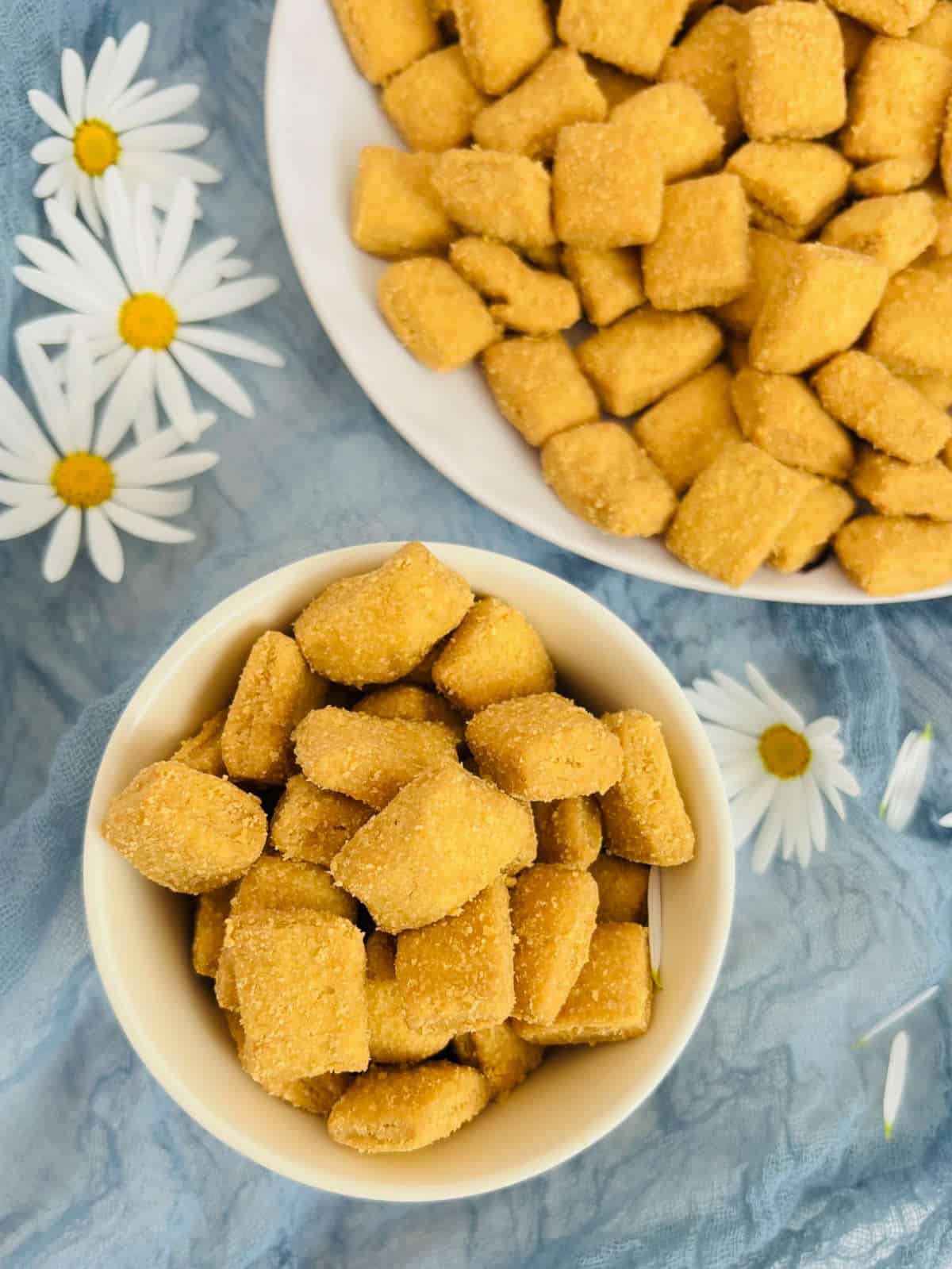
If you tried this Sweet Shankarali Recipe or any other recipe on my website, please leave a ? star rating and let me know how it went in the ? comments below.
Recipe card

Sweet Shankarpali
Ingredients
- 5 tablespoon ghee (use store-bought or homemade ghee)
- ¼ cup milk
- ¼ cup sugar
- 1-1¼ cup all-purpose flour
- ¼ teaspoon salt
- 1 tablespoon semolina
- Oil for deep frying
Instructions
Make the dough:
- In a saucepan, mix together milk and ghee. Heat on medium flame until the ghee melts.
- Remove from heat and mix the sugar, salt, and semolina into it. Let the sugar dissolve completely.
- Slowly add the flour to the mixture and knead together into a stiff dough.
- It is important not to over-knead dough at this stage. Just bring it together and let it rest (see notes below).
- Cover with a damp kitchen towel and let the dough rest for 30 minutes.
- Knead the dough again for a couple of minutes. Divide them roughly into 4 equal parts.
- Roll out the dough into thick discs.
- Cut into small squares using a pizza cutter or knife.
- Rest the cut shapes for 15 minutes.
Fry the shankarpali:
- Heat oil in a deep frying pan. To check if the oil is ready, drop a small bit of dough into it. It should sizzle immediately and slowly rise to the top. If it does not sizzle and rise, let it heat more.
- Once the oil is hot enough, fry the shankarpali in batches on medium heat until they are golden brown.
- Drain on a kitchen towel and cool completely.
- Store in an airtight container.

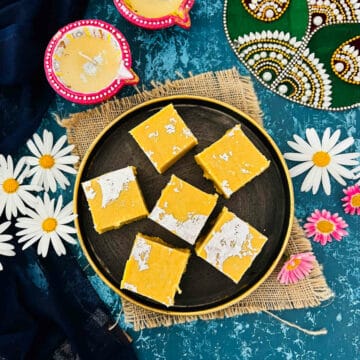
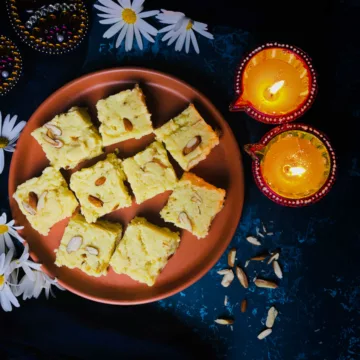
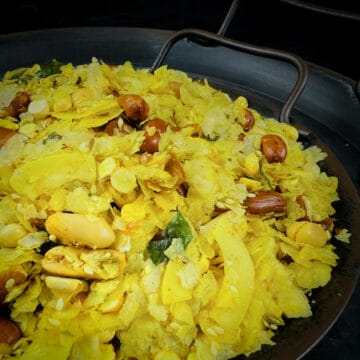
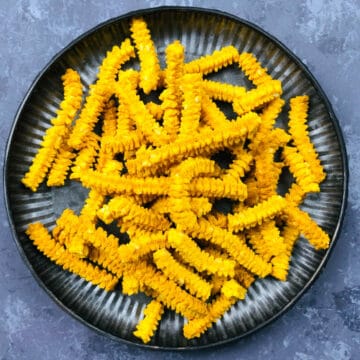
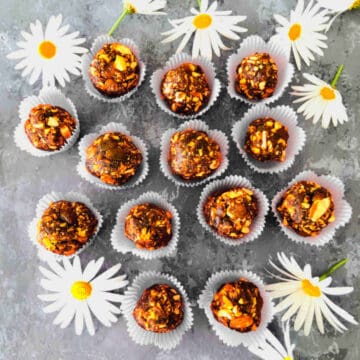
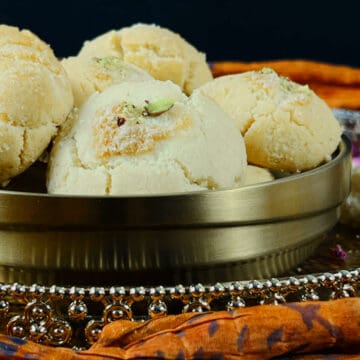
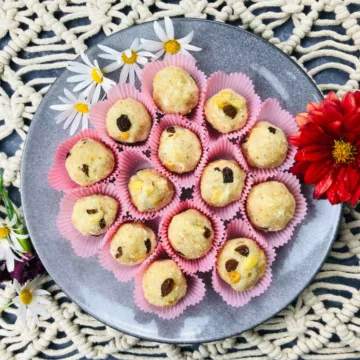
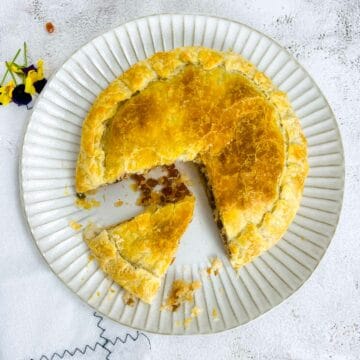

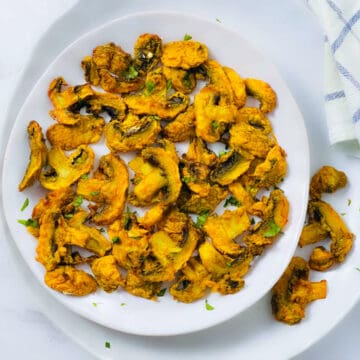
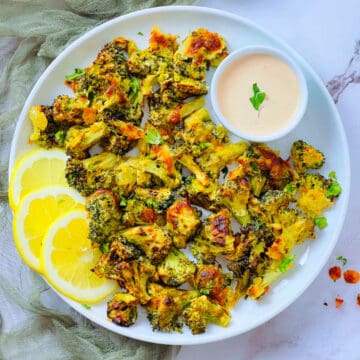
Comments
No Comments